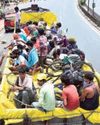Having made significant inroads into the State during the local body elections, the BJP moves into top gear in its mission to consolidate its

AFTER its impressive performance in the Odisha panchayat elections in February, the Bharatiya Janata Party (BJP) is currently drawing up plans to take on the Biju Janata Dal (BJD) and conquer Odisha. The party held a two-day national executive meeting in Bhubaneswar in mid April, which boosted the morale of the party cadre. The Varanasi-like road show by Prime Minister Narendra Modi in the State capital, which was attended mostly by BJP workers from all over the State, was hyped by the saffron party with the help of a section of the media. Television channels and newspapers have been creating the impression that the party cannot wait to contest the elections in 2019.
In its efforts to make its presence felt in the 36,000 polling booths, the BJPhas announced its plans to make Odisha the laboratory of welfare schemes for the poor. The implementation of the Pradhan Mantri Ujjwala Yojana is being accorded top priority to take the Modi government’s message to more rural areas in the State.
The BJP, which has a strong presence in the interior parts of the State, has also started the process of strengthening its base in the coastal regions, where it fared relatively well in the local body elections in some districts such as Khurda and Kendrapara. It has already tried to strike a chord with the people of Odisha with Modi felicitating the descendants of martyrs of the Paika rebellion during his two-day visit to attend the national executive meet.
Drawing up strategies to woo voters ahead of elections is nothing new, but any party needs workers at the grass-roots level to effectively implement them, which the BJP does not have in the State although it won nearly 300 zilla parishad seats out of 846 in this year’s local body elections compared with just 36 in 2012.
Denne historien er fra May 12, 2017-utgaven av FRONTLINE.
Start din 7-dagers gratis prøveperiode på Magzter GOLD for å få tilgang til tusenvis av utvalgte premiumhistorier og 9000+ magasiner og aviser.
Allerede abonnent ? Logg på
Denne historien er fra May 12, 2017-utgaven av FRONTLINE.
Start din 7-dagers gratis prøveperiode på Magzter GOLD for å få tilgang til tusenvis av utvalgte premiumhistorier og 9000+ magasiner og aviser.
Allerede abonnent? Logg på

How Not To Handle An Epidemic
The lockdowns were meant to buy time to put in place appropriate health measures and contain the coronavirus’ spread, but they have failed to achieve the objective and heaped immense misery on the marginalised sections of society. India is still in the exponential phase of the COVID-19 infection and community transmission is a reality that the government refuses to accept.

Tragedy on foot
As the COVID-19-induced lockdown cuts the ground beneath their feet in Tamil Nadu, thousands of migrant workers are trudging along the highway to the relative safety of their upcountry homes.

Sarpanchs as game changers
Odisha manages to keep COVID-19 well under control because of the strong participation of panchayati raj institutions and the community at the grass-roots level under the leadership of Chief Minister Naveen Patnaik.

Scapegoating China
As the COVID-19 death rate spikes and the economy tanks in the United States, Donald Trump and his advisers target China and the World Health Organisation with an eye to winning the forthcoming presidential election.

New worries
Kerala’s measured approach to the pandemic and lockdown has yielded results. But it still has to grapple with their huge economic impact on its economy, which it feels the Centre’s special financial relief package does little to alleviate.
No love lost for labour
Taking advantage of the lockdown and the inability of workers to organise protests, many State governments introduce sweeping changes to labour laws to the detriment of workers on the pretext of reviving production and boosting the economy.

Capital's Malthusian moment
In a world that needs substantial reorienting of production and distribution, Indian capital is resorting to a militant form of moribund neoliberalism to overcome its current crisis. In this pursuit of profit, it is ready and willing to throw into mortal peril millions whom it adjudicates as not worth their means—an admixture of social Darwinism born of capital’s avarice and brutalism spawned by Hindutva. .

Understanding migration
When governments and their plans are found to be blatantly wanting in addressing reverse migration, exercises such as the Ekta Parishad’s survey of migrant workers throughout India can be useful to work out creative long-lasting solutions.

Waiting for Jabalpur moment
The Supreme Court’s role in ensuring executive accountability during the ongoing lockdown leaves much to be desired. Standing in shining contrast is the record of some High Courts.

An empty package
The Modi regime, which has been unable to control the COVID-19 infection, restore economic activity and provide relief to millions exposed to starvation, trains its sights on Indian democracy, making use of the panic generated by fear and a lockdown that forecloses paths of resistance.